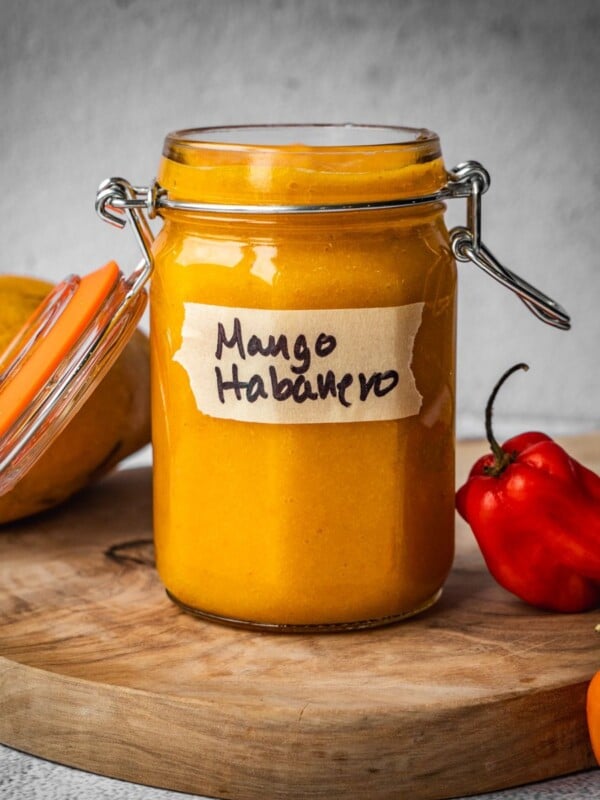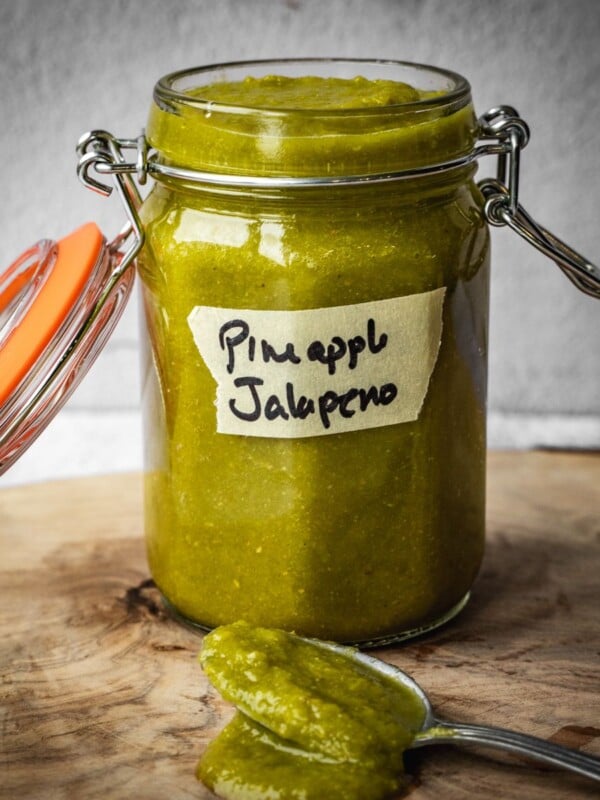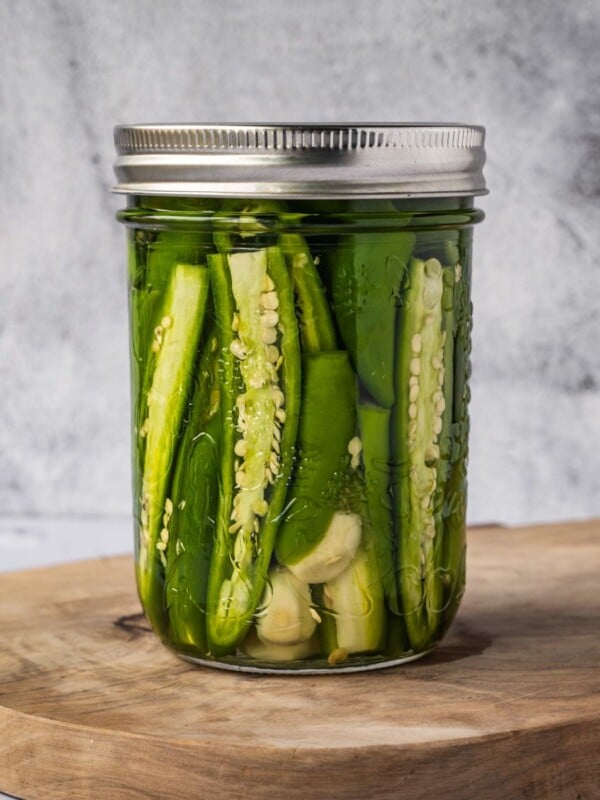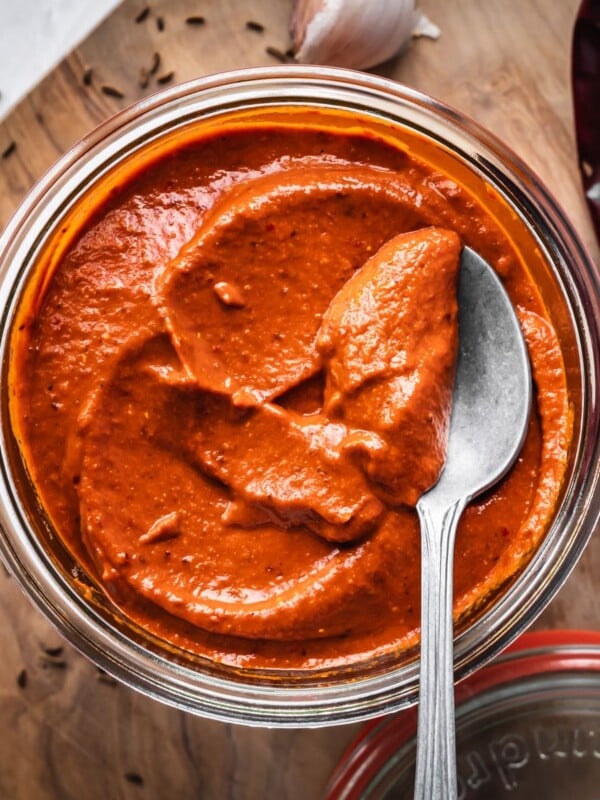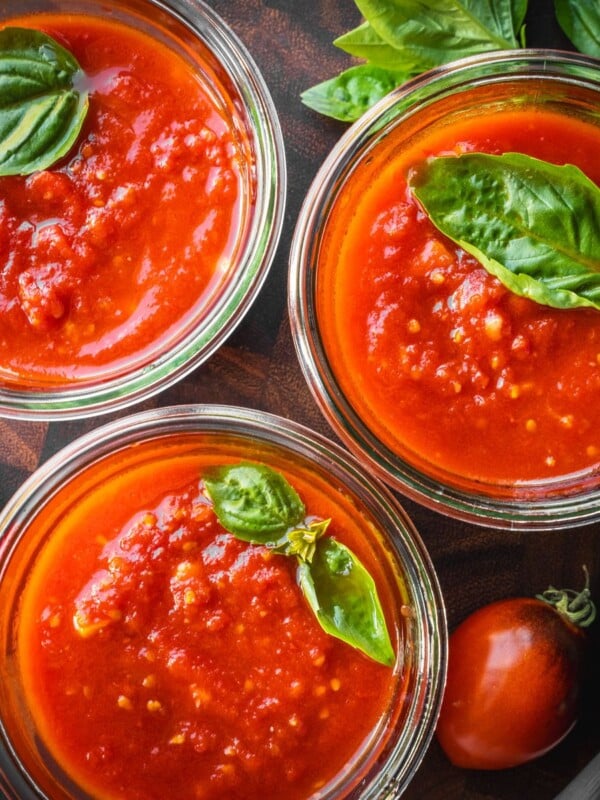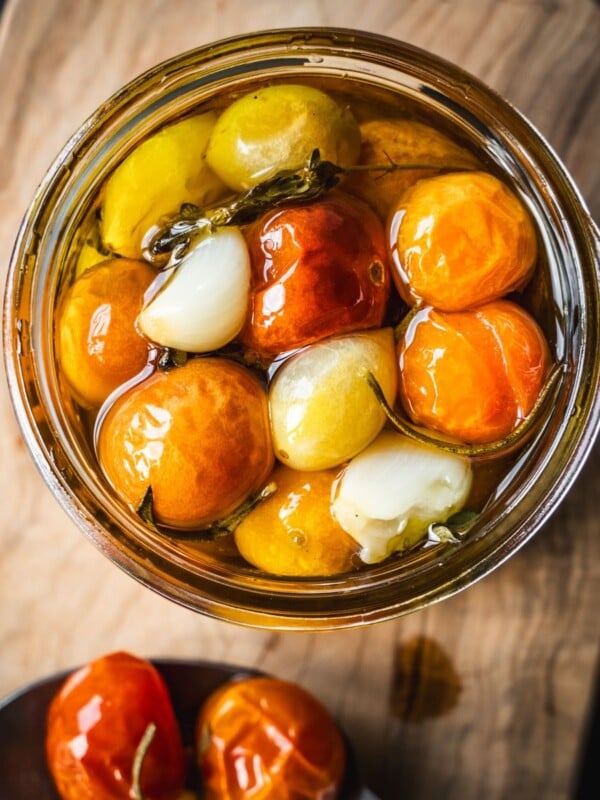This 5-ingredient recipe for Red Cabbage Sauerkraut (Lacto-fermented red cabbage) is a slight twist on traditional sauerkraut. It is a jumping-off point into the wonderful world of fermentation. It’s easy to prepare and incredibly rewarding.
This recipe is featured in my 11 Easy and Straightforward Fermentation Recipes post.

Table of Contents
- A Note on Lacto-Fermentation
- How to Choose the Right Cabbage
- Ingredients
- Ingredient Notes and Substitutions
- How Much Salt to Use by Weight
- Equipment and Supplies
- How to Make Lacto-Fermented Red Cabbage
- Storage and Safety
- Expert Tips
- Recipe FAQs
- Other Fermenting Recipes You Will Enjoy
- Red Cabbage Sauerkraut (Simple Fermented Cabbage) Recipe
A Note on Lacto-Fermentation
Fermentation (more precisely lacto-fermentation) involves submerging fruits and vegetables in a brine solution (salt and water). Rather than killing bacteria (like pickling typically does), this process takes a different approach. When done correctly, fermentation kills or suppresses the bad bacteria while giving the beneficial bacteria a chance to thrive.
This process transforms the vegetables and/or fruits into healthy, probiotic-rich lacto-fermented food.
If you’ve ever tasted kimchee (like Korean Radish Kimchi) or traditional fermented green sauerkraut, you’ll notice they have an acidity that is different from a traditional vinegar pickle. They taste tangy as opposed to pickled. Furthermore, they may even tingle on your tongue. This fizziness is attributed to the carbon dioxide that is generated in the fermentation process.
If this is your first-time fermenting, I suggest you read my comprehensive post on lacto-fermentation. It’ll give you all the basics you need to successfully and confidently ferment all the vegetables! I encourage you to try some of my other fermentation recipes like fermented jalapenos, fermented celery, fermented radishes, fermented carrots, fermented cucumbers, fermented lemons, fermented tomatoes, Sambal Oelek (Indonesian chili paste) and fermented hot sauce.
How to Choose the Right Cabbage
Choose a fresh, firm red or purple cabbage without any signs of wilting or browning. Freshness ensures a crisp and flavorful sauerkraut. I would avoid using napa or Chinese cabbage to make sauerkraut (save those to make another fermented cabbage recipe, Kimchi).

Look for medium-sized cabbages. They are easier to handle and cut. Extremely large cabbages might have a woodier core, which can affect the texture of your sauerkraut. Select dense, heavy cabbages. Heavier cabbages often have higher water content, which is beneficial during the fermentation process (we want the cabbage to release as much water as possible).
If possible, choose organic cabbage to avoid pesticides and chemicals. However, if organic cabbage is not available or affordable, thoroughly wash and remove the outer leaves of conventional cabbage before using them. I grow different types of cabbages in my garden. I encourage you to consider adding this versatile vegetable to your garden come spring or fall.
Ingredients
5 Ingredients! That is all you need to make this twist on homemade sauerkraut.

Ingredient Notes and Substitutions
- Cabbage. Use fresh cabbage. Red, firm and dense cabbage is best for this recipe. It is possible to make this recipe with green cabbage too (or just follow my traditional Fermented Cabbage Sauerkraut recipe.
- Salt: When fermenting, it is important to use kosher salt, pickling salt, or unrefined sea salt. Avoid using table salt as it has iodine added to it which may possibly hinder fermentation.
- Spices: Traditional sauerkraut only has caraway seeds, but this recipe is a twist on the traditional and includes caraway, mustard and bay leaves. It might be difficult to find caraway seeds in your regular grocery store. You can try your local Eastern European store or Middle Eastern store.
See the recipe card for full information on ingredients and quantities.
How Much Salt to Use by Weight
The amount of salt needed for fermentation varies depending on the type of food you are fermenting. The general rule of thumb is to use about 2 to 3% salt by weight of the vegetables or fruits being fermented. Here’s how you can calculate it:
- Weigh Your Vegetables/Fruits: Let’s say you have 600 grams of cabbage you want to ferment.
- Calculate the Salt Percentage: For a moderate salt concentration, you can use 2.5% salt. To find out how much salt you need, multiply the weight of your vegetables by 0.025 (which represents 2.5%).
So, in this case, you would need 15 grams of salt to achieve a 2.5% salt concentration. I recommend using a kitchen scale (affiliate link) to achieve this level of precision.
Equipment and Supplies
A fermentation lid (also known as an airlock) is not essential, but highly recommended. This is a lid with a valve that allows gasses to escape safely. It fits directly onto your jar. There are several airlock lids on the market like the Klemon and Masontops (affiliate links).
You can use a standard lid and unscrew it twice a day to let any built-up air escape and quickly reseal. This option is not ideal as it can allow oxygen back in.

Fermentation glass weights (affiliate link) are also important. They are versatile and can help extract water from a dry salted ferment. Alternatively, you can use a plastic bag (ziplock) filled with water, salt brine or marbles to act like a weight.
I recommend using a glass jar (a mason jar is perfect because many of the lids mentioned above are designed specifically for it). You can also use another fermentation vessel such as a fermentation crock (affiliate link). I personally avoid metal and plastic containers (though there are many who use plastic containers).
Fermenting fruits and vegetables is quite safe and generally foolproof. But to make sure that you are not introducing any bad bacteria or mold in the fermenting process, keep your equipment and tools as clean as possible. You don’t need to sterilize them (as you would if you are canning), but washing everything in soapy warm water and air drying them is the best way to reduce the risk of cross-contamination.
How to Make Lacto-Fermented Red Cabbage
There are several steps to this recipe, so make sure to read through them once.

1. Chop. Finely shred the red cabbage into really thin slices. You can use a knife or a mandoline (Image 1).
2. Weigh. Place a large bowl on a kitchen scale and zero it. Transfer the chopped cabbage to the bowl and weight it. This will help you calculate the amount of salt needed (Image 2).
3. Salt. Multiply the weight of your cabbage in grams by 0.025. This is the amount of salt you need to add to the cabbage. Make sure to tare (or zero) the scale before adding the salt (Image 3).
4. Massage. Massage the cabbage with the salt for 2-3 minutes. Set aside (Image 4).

5. Liquid. After about 15 minutes you should start seeing purple water at the bottom of the bowl. This is a good sign and means your cabbage is wilting (Image 5).
6. Season. Add the loose spices and mix them in. I suggest you keep the bay leaves whole and add them to the jar in the next step (Image 6).
7. Pack. Transfer the wilted red cabbage and all the juice to a clean mason jar. Using a tamper or wooden spoon, push down. Place the bay leaves against the sides of the jar so they don’t get crushed when tamping. You should see purple liquid come up (Image 7).
8. Cover. Add a piece of cabbage leaf on top of the shredded cabbage mixture. This will prevent any small pieces of cabbage from floating up during the fermentation process (Image 8).

9. Weight. Apply the fermentation weight and press down (Image 9).
10. Cover. Cover the jar with a fermentation lid, or standard lid if that’s all you have (Image 10).
11. Check the liquid level. The next day, check to make sure there is enough liquid covering all the cabbage. If not, top off with lightly salted water just enough to cover the cabbage (Image 11).
12. Ferment. Ferment on a counter away from direct sunlight for at least 7 days. After 7 days, taste your sauerkraut. If you want to continue fermenting it, put the weight and lid back on. You can ferment for another week or even more. If you’re happy with the taste, remove the weight, fermentation lid and cabbage leaf. Apply a standard lid and place the kraut in the fridge (Image 12).
Storage and Safety
While the cabbage is fermenting it is best to keep it on the counter away from direct sunlight. You can also keep it in a dark place like a cabinet if you wish. The ideal fermenting temperature is 60°F to 75°F (15°C to 24°C). In other words, room temperature.
Fermenting time depends on your personal taste. Some people prefer a milder sauerkraut, so a 3-4 day fermentation works for them. Others prefer a more traditional, longer ferment (2 weeks or even longer).
Finished sauerkraut should be kept in the fridge. This is the safest way to store it and it will last for several months this way.

Expert Tips
- Food processor. If you’re looking to save time, use your food processor with the shredding attachment to shred the red cabbage head.
- Use glass jars. Avoid using plastic or metal containers as those may react with the contents. Glass mason jars are ideal.
- Keep it clean. Sterilize your jars and utensils before using them to prevent unwanted bacterial growth. You can sterilize jars and tools by washing them in hot soapy water and then boiling them for 5 minutes.
- Safety first. Make sure to refrigerate your final product in the fridge. Don’t leave it out on the counter.
Recipe FAQs
The origins of sauerkraut can be traced back over 2,000 years to ancient China, where laborers building the Great Wall of China were said to have consumed fermented cabbage for its nutritional benefits. It later spread to Europe, particularly Germany, where it became a staple food. The name “sauerkraut” translates to “sour cabbage” in German, which accurately describes its tangy flavor.
When making your own sauerkraut at home, you have the flexibility to ferment it for as little or as long as you like. The minimum fermentation time is 3 days, but you can ferment it for up to 2 weeks (or longer) for an extra tangy and sour sauerkraut.
A cloudy brine in fermentation is a common occurrence and usually not a cause for concern. It could be due to yeast or microbial activity, or simply starches and proteins from the breaking down of the fruits and vegetables. Always trust your senses; if something looks or smells off, it’s best to err on the side of caution and discard the ferment. When in doubt, throw it out.
Other Fermenting Recipes You Will Enjoy
Fermentation
Fermentation
Fermentation
Fermentation
If you make your own Red Cabbage Sauerkraut (Simple Fermented Cabbage) or any other fermentation recipe on Urban Farm and Kitchen, please take a moment to rate the recipe and leave a comment below. It’s such a help to others who want to try the recipe.
For more Urban Farm and Kitchen, follow along on Instagram, Facebook, and Pinterest, visit the Urban Farm Shop, or subscribe for new posts via email.
Red Cabbage Sauerkraut (Simple Fermented Cabbage)
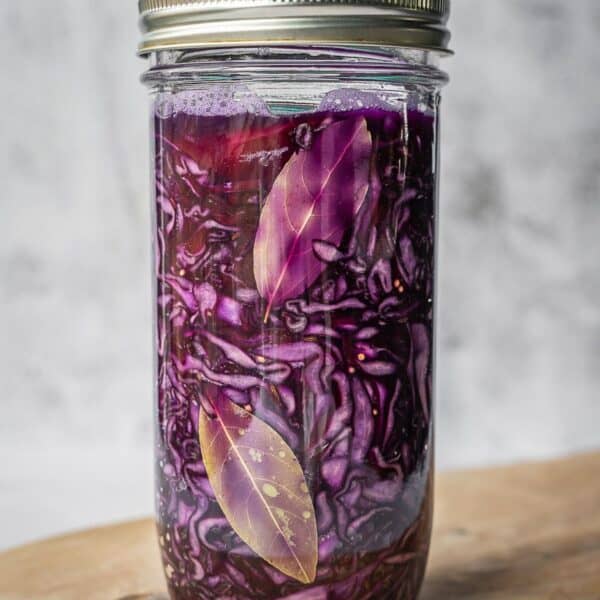
Equipment
- ¾ quart mason jar (24 fl oz mason jar)
- Regular canning jar lid
Ingredients
- 600 grams Red Cabbage, shredded finely – 21ounces – about half a medium-sized head of red cabbage
- 15 grams Kosher, pickling or sea salt – about 1 tablespoon
- 2 grams Caraway Seeds – 1 teaspoon
- 2 grams Mustard seeds – 1 teaspoon
- 2 Bay leaves
Instructions
- Chop. Start by removing the outer leaves of the red cabbage and cutting your head of cabbage in half. Cut one half into quarters (save the other half for another recipe or double this one). Remove the tough core and finely chop the cabbage quarters into really thin slices. You can use a sharp knife or a mandoline.
- Weigh. Place a large bowl on a kitchen scale and zero it. Transfer the chopped cabbage to the bowl and weight it. This will help you calculate the amount of salt needed.
- Salt. Multiply the weight of your cabbage in grams by 0.025. This is the amount of salt you need to add to the cabbage. Make sure to tare (or zero) the scale before adding the salt.
- Massage. With clean hands, massage the sliced cabbage with the salt for 2-3 minutes. Set aside.
- Liquid. After about 15 minutes you should start seeing purple water at the bottom of the bowl. This is a good sign.
- Season. Add the loose spices and mix them in. I suggest you keep the bay leaves whole and add them to the jar in the next step.
- Pack. Transfer the wilted red cabbage and all the juice to a clean mason jar. Using a tamper or wooden spoon, push down. Place the bay leaves against the sides of the jar so they don’t get crushed when tamping. You should see purple liquid come up.
- Cover. Add a piece of cabbage leaf on top of the shredded cabbage mixture. This will prevent any small pieces of cabbage from floating up.
- Weight. Apply the fermentation weight and press down. If you don’t have fermentation weights you can use a Ziplock bag filled with water or marbles to weigh down the cabbage.
- Cover. Cover the jar with a fermentation lid, or standard lid if that’s all you have (if you use a standard lid you will have to burp the jar once or twice a day during the fermentation process to release the built-up gasses).
- Check the liquid level. The next day, check to make sure there is enough liquid covering all the cabbage. If not, top off with lightly salted water just enough to cover the cabbage.
- Ferment. Ferment on a counter away from direct sunlight for at least 7 days. After 7 days, taste your sauerkraut. If you want to continue fermenting it, put the weight and lid back on. You can ferment for another week or even more if you really like your kraut sour. If you’re happy with the taste, remove the weight, fermentation lid and cabbage leaf. Apply a standard lid and place the kraut in the fridge.
Notes
- While the cabbage is fermenting it is best to keep it on the counter away from direct sunlight. You can also keep it in a dark place like a cabinet if you wish. The ideal fermenting temperature is 60°F to 75°F (15°C to 24°C). In other words, room temperature.
- Finished sauerkraut should be kept in the fridge. This is the safest way to store it and it will last for several months this way.
Nutrition
Nutrition information is automatically calculated, so should only be used as an approximation.
 Like this recipe? Rate & comment below!
Like this recipe? Rate & comment below!
